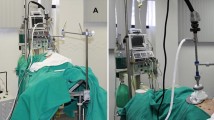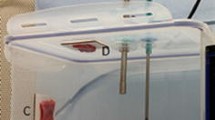Abstract
PURPOSE: This study was undertaken to investigate the ability of a high-pressure CO2 environment to aerosolize tumor cells in bothin vitro and in vivo models. (An aerosol is defined as a stable gaseous suspension of insoluble particles.) Also, this study was designed to determine if rapid desufflation is capable of transporting fluid laden with tumor cells. METHODS: The fourin vitro aerosol experiments were performed in an 18.9-l plastic vessel fitted with two 7-mm ports and a compliant latex balloon affixed to the top. After CO2 insufflation, the vessel was desufflated through a sterile soluset containing 25 ml of culture media that was subsequently emptied into a culture dish, incubated for two weeks, and periodicallyassessed for growth. At the bottom of the vessel, one of the following was placed: Study 1 and 2, a suspension of B16 melanoma or colon 26 tumor cells in liquid culture media; Study 3, colon 26 cells in saline solution; Study 4, several pieces of solid colon 26 tumor. In Studies 1 to 3, cell preparations were subjected to the following high-pressure CO2 conditions (pneumo): 1) static pneumo of 15 and 30 mmHg (10 minute dwell); 2) a continuous flow (CF) of CO2 (10 l) while maintaining a pressure of 15 or 30 mmHg in the vessel. In Study 4, only the 30 mmHg static and CF conditions were tested. Between 6 and 12 determinations were performed for each condition and cell preparation.In vivo aerosol experiments consisted of Spraque Dawley rats that received intraperitoneal injections of 10-5 B16 cells in 0.1 ml of liquid media.Two laparoscopic ports were placed in the abdomen, one each for insufflation and desufflation. Study groups were: 1, static CO2 pneumo of 15 mmHg; 2 and 3, continuous CO2 flow (10 l) at a stable pneumo pressure of 5 and 10 mmHg. Desufflation was performedvia the same collecting device and handled in an identical manner to thein vitro experiments described above. The in vitro balloon experiment was designed to investigate the ability of desufflation to transport fluid-containing tumor cells; latex balloon model was used. To prevent complete loss of volume on desufflation, a wire coil was placed inside the balloon. Twenty ml of media containing 20×10−6B16 cells was placed in the bottom of the balloon. The balloon was insufflated with 1 to 21 of gas. There were three study groups that differed in the degree to which the cell suspension was agitated before desufflation. Study conditions were as follows: 1) no agitation; 2) moderate agitation to coat the lower walls and coil; 3) maximum agitation to coat the entire balloon. To verify the viability of tumor cells,at the end of eachin vitro and in vivo study, a sample of tumor cells or peritoneal washing was incubated in sterile media. These samples served as positive controls. RESULTS:In vitro aerosol studies consisted of the following. At the end of two weeks of incubation, no tumor growth was noted in any of the 124 test dishes. The 14 control samples all demonstrated tumor growth.In vivo aerosol studies consisted of the following. Zero of 18 experimental dishes grew tumor. All three peritoneal washing samples demonstrated growth.In vitro balloon studies consisted of the following. Zero of 12 test dishes in Groups 1 and 2 demonstrated growth, whereas five of six dishes did so in Group 3 (maximally agitated before desufflation). Again, positive controls all grew tumor cells. SUMMARY: We were unable to demonstrate aerosol formation in any of thein vitro and in vivo studies performed. In the balloon experiment, desufflation-related transport of tumor cells was demonstrated but only when the entire balloon surface was coated with the tumor cell suspension before desufflation. CONCLUSION: Aerosols of tumor cells are not likely to form. Free intraperitoneal tumor cells are most likely found in liquid suspension. Desufflation is a potential means of transport of cell-laden fluid.
Similar content being viewed by others
References
Wexner SD, Cohen SM. Port site metastases after laparoscopic colorectal surgery for cure of malignancy. Br J Surg 1995;82:295–8.
Nduka CC, Monson JR, Menzies-Gow N, Darzi A. Abdominal wall metastases following laparoscopy. Br J Surg 1994;81:648–52.
Fusco MA, Paluzzi MW. Abdominal wall recurrence after laparoscopic-assisted colectomy for adenocarcinoma of the colon: report of a case. Dis Colon Rectum 1993;36:858–61.
Franklin ME Jr, Rosenthal D, Dorman JP, Glass JL, Norem R, Diaz A. Prospective comparison of openvs. laparoscopic colon surgery for carcinoma: five year results. Dis Colon Rectum 1996;39:S35–46.
Jones DB, Guo WL, Reinhard MK,et al. Impact of pneumoperitoneum on trocar site implantation of colon cancer in hamster model. Dis Colon Rectum 1995;38:1182–8.
Hughes ES, McDermott FT, Polglase AL, Johnson WR. Tumor recurrence in the abdominal wall scar tissue after large bowel cancer surgery. Dis Colon Rectum 1983;26:571–2.
Hansen E, Wolff N, Knuechel R, Ruschoff J. Tumor cells in blood shed from the surgical field. Arch Surg 1995;130:389–93. Table 1. Results of Static Large Bottle Experiments
Author information
Authors and Affiliations
Additional information
Read at the meeting of The American Society of Colon and Rectal Surgeons, Seattle, Washington, June 9 to 14, 1996.
About this article
Cite this article
Whelan, R.L., Sellers, G.J., Allendorf, J.D. et al. Trocar site recurrence is unlikely to result from aerosolization of tumor cells. Dis Colon Rectum 39 (Suppl 10), S7–S13 (1996). https://doi.org/10.1007/BF02053799
Issue Date:
DOI: https://doi.org/10.1007/BF02053799




